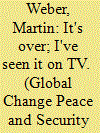|
|
|
Sort Order |
|
|
|
Items / Page
|
|
|
|
|
|
|
| Srl | Item |
| 1 |
ID:
138966


|
|
|
|
|
| Summary/Abstract |
This writing analyzes the use of symbols, art, and aesthetics in the first phase of Hong Kong’s “Occupy Central” movement. Protestors, demonstrators, and strikers appropriate symbols to put their political messages across, sometimes essentializing or reducing complicated and complex ideologies or reform initiatives to pictorial symbols and performative sessions to parsimoniously put their points across. Between the start of Hong Kong’s “Occupy Central” movement on 27 September 2014 and its temporary pause on 6 October 2014, many symbols and art forms were used to symbolize the protests including the yellow umbrella. This writing is based on the observations in Hong Kong (more than 4 years) as well as formal and informal discussions with individuals representing positions from all sides of the political divides (pro-government, pro-democracy, and pro-Beijing forces) within and outside Hong Kong. Textually, I collected media reports, downloaded digital images, and scanned and analyzed media commentaries for this writing.
|
|
|
|
|
|
|
|
|
|
|
|
|
|
|
|
| 2 |
ID:
118025


|
|
|
|
|
| Publication |
2013.
|
| Summary/Abstract |
Quick vignettes on the meaning of political events are an undertaking fraught with risks. Not least by facilitating overstatements, biases, and shortcuts, the latter both empirically and conceptually. What follows here should therefore be seen as nothing more than an offer of one way of framing an inquiry into the question of what the significance of the Occupy movement has been. It is emphatically not an attempt to cook the movement by way of reduction into an 'explanatory hotel-sauce' (taking Adorno's much loved phrase out of context here), to be poured retrospectively over events to make them analytically palatable. Rather than detracting from the diversity of experiences, modes of engagement, imaginaries, and resilience developed in very different sites and situations by people associating with, or inspired by, the 'Occupy' meme, I am simply trying to home in on one particular aspect, which, I think, may contain some hints about the continuities of the political concerns to which the 'events' side of Occupy gave voice, visibility, and exposure.
|
|
|
|
|
|
|
|
|
|
|
|
|
|
|
|
|
|
|
|
|